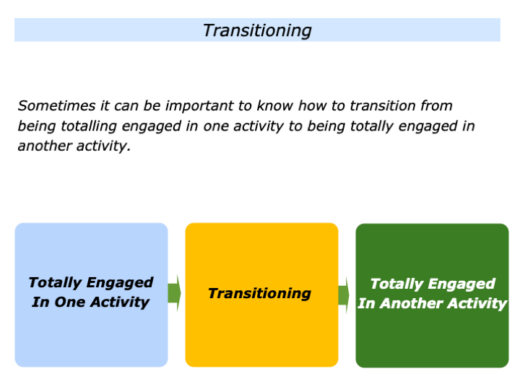
Peak performers often immerse themselves deeply in their chosen activities. They love to go through the process of absorption, adventure and achievement. Sometimes they enter a state of flow.
This has huge benefits, but there can also be challenges. They may be deeply engaged in a creative activity, for example, but then need to give full attention to their child or partner.
Top performers also need to make such transitions. The skills they learn to do this may have some things in common but the ways they practise these may differ.
A soccer player may move from being adrenaline driven to being calm before taking a penalty kick. A business leader may move from making big strategic decisions to giving personal attention to individuals they meet in the corridor.
Looking back, can you think of a situation in the past when you managed to make a transition successfully? This could have a situation in your personal or professional life. You may have been deeply engaged in a task but suddenly your flow was interrupted.
This may have involved an everyday event, such as breaking off what you were doing to welcome home your loved one. Or it may have been something more dramatic, such as an emergency at work.
What did you do right then to make the transition? You may have taken time to breathe deeply, relax and refocus on the next activity. Clarifying your aims in the new situation, you then did everything possible to achieve success. What did you actually do to make this happen?
If you wish, try tackling the exercise on this theme. This invites you to do the following things.
Describe a specific situation when you were totally engaged in one activity and then made a successful transition to become totally engaged in the next activity.
Describe the specific things you did to make this transition successfully.
Describe the specific things that happened as a result of taking these steps.
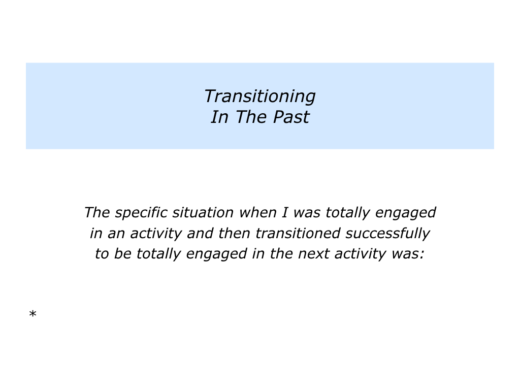
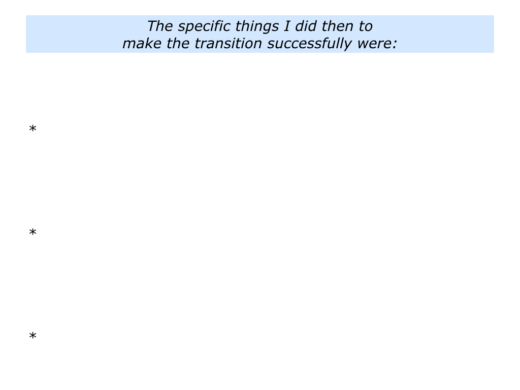
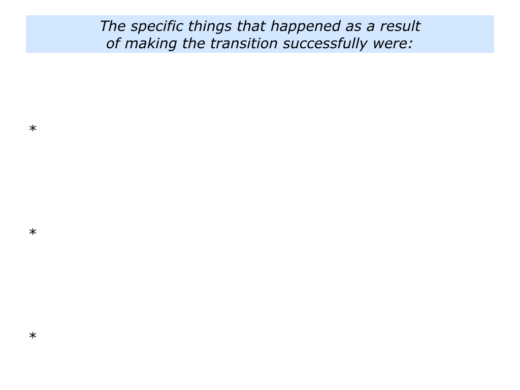
Different people follow these steps in different ways in their own fields. Here is a look at how some athletes take these steps.
Learning From Biathletes
Tom Weede wrote an article on this theme for Men’s Fitness magazine. He describes how people competing in the biathlon must switch from high intensity skiing to the calmness required to shoot at a target. He interviewed top US biathletes such as Jay Hakkinen, plus the team coach Algis Shalna.
DE-STRESS IN SECONDS
As a result of the alternating demands of furious cardio and calm precision, these biathletes have to know how to relax and focus in highly stressful situations.
Remain Calm
On days when you’ll be called upon to do something stressful, practise staying relaxed throughout the day — as opposed to hastily trying to compose yourself when you’re about to give a presentation or line up a one-metre putt.
Breathe Deeply
In addition to being in good condition, biathletes increase their ability to relax and lower their heart rates by breathing correctly, deeply inhaling and exhaling as they approach the shooting range during a race.
Make It Mechanical
One way to reduce stress is by practising something over and over until it becomes automatic.
But biathletes can miss their targets, just as the rest of us miss free throws or lose our train of thought. So what happens if you fall out of the automatic mode and mess up?
“You definitely have to stop,” says team member Jeremy Teela, who deals with such times by taking two breaths, closing his eyes for a second and then starting over.
“I jump back into it, just like I would if it was a new shooting,” he says. “And then I shoot the next shots just as fast as normal … so I totally clear what I just did (from my mind) and then start over.”
Different people use different tools for making transitions. Many of these techniques involve going through the following process.
Relax
Relax your mind and body. Breathe deeply and buy time, even if only for a few seconds.
Rehearse
Clarify the real results you want to achieve in the situation. You can then rehearse how to achieve these aims.
(It is important to clarify what you can and cannot control in the situation. You can do your best but you cannot always completely control the outcome.)
Refocus
Focus fully on the new situation and move into action. Be totally aware of what is happening and do your best to achieve the desired results.
Let’s return to your own life and work. Looking ahead, can you think of a situation where you may be totally engaged in an activity and then need to make a transition?
What can you do to be calm, controlled and centred? What can you do to, if appropriate, buy time – if only for a few seconds? What can you then do to be totally engaged in the new situation?
If you wish, try tackling the exercise on this theme. Looking to the future, this invites you to do the following things.
Describe a specific situation in which you may be totally engaged in one activity but then need to make a successful transition to become totally engaged in the next activity.
Describe the specific things you can do to make this transition successfully.
Describe the specific things that may happen as a result of taking these steps.
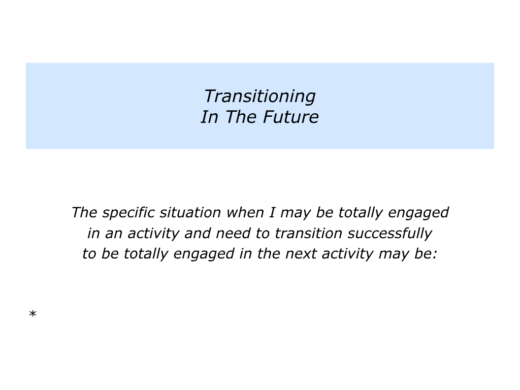
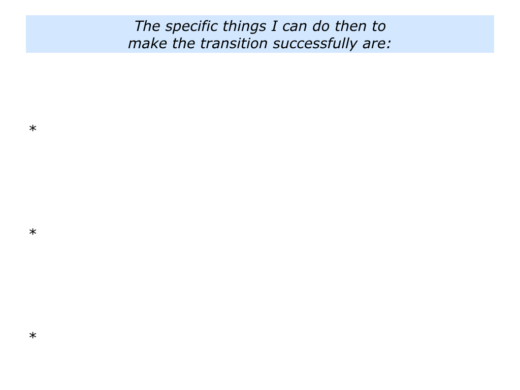
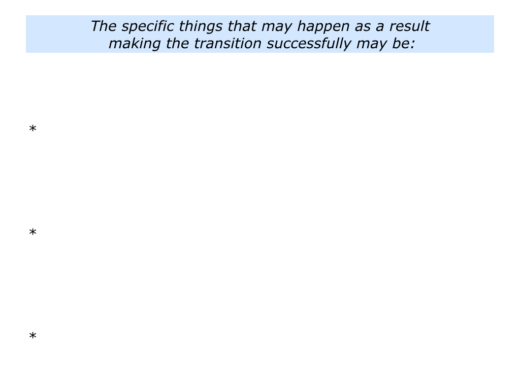






[…] Making Transitions […]